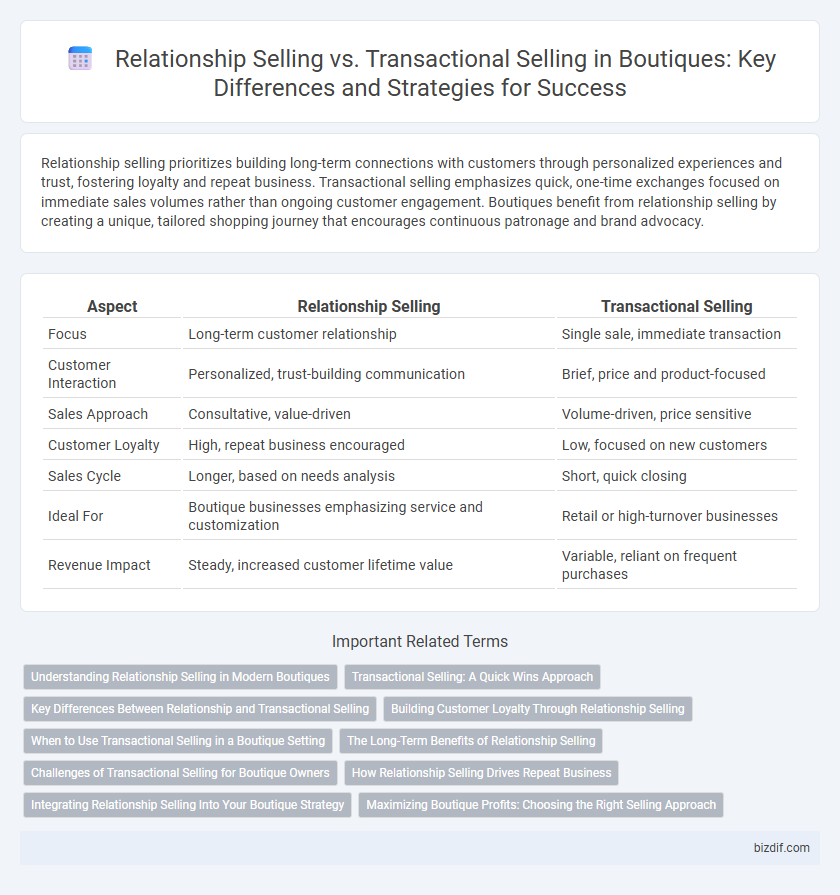Relationship selling prioritizes building long-term connections with customers through personalized experiences and trust, fostering loyalty and repeat business. Transactional selling emphasizes quick, one-time exchanges focused on immediate sales volumes rather than ongoing customer engagement. Boutiques benefit from relationship selling by creating a unique, tailored shopping journey that encourages continuous patronage and brand advocacy.
Table of Comparison
| Aspect | Relationship Selling | Transactional Selling |
|---|---|---|
| Focus | Long-term customer relationship | Single sale, immediate transaction |
| Customer Interaction | Personalized, trust-building communication | Brief, price and product-focused |
| Sales Approach | Consultative, value-driven | Volume-driven, price sensitive |
| Customer Loyalty | High, repeat business encouraged | Low, focused on new customers |
| Sales Cycle | Longer, based on needs analysis | Short, quick closing |
| Ideal For | Boutique businesses emphasizing service and customization | Retail or high-turnover businesses |
| Revenue Impact | Steady, increased customer lifetime value | Variable, reliant on frequent purchases |
Understanding Relationship Selling in Modern Boutiques
Relationship selling in modern boutiques emphasizes building long-term customer connections by prioritizing personalized service, understanding individual client preferences, and fostering trust. This approach enhances customer loyalty and encourages repeat business through tailored experiences and consistent engagement. Unlike transactional selling, it focuses on creating value beyond the immediate purchase, driving sustainable growth for boutique brands.
Transactional Selling: A Quick Wins Approach
Transactional selling emphasizes rapid, one-time purchases by prioritizing quick wins and immediate customer needs over long-term relationships. This approach suits boutique settings aiming to maximize sales volume with straightforward product offerings and minimal customer interaction. Efficiency and speed are key, enabling boutiques to attract impulse buyers and generate fast revenue through targeted promotions and clear pricing.
Key Differences Between Relationship and Transactional Selling
Relationship selling emphasizes building long-term customer trust and loyalty by understanding individual client needs, whereas transactional selling focuses on single, one-time sales with minimal interaction. Relationship selling involves personalized communication, ongoing support, and customized solutions, contrasting with transactional selling's goal of quick, efficient exchanges and price-driven decisions. Key differences include the sales approach, customer engagement level, and focus on customer retention versus immediate revenue generation.
Building Customer Loyalty Through Relationship Selling
Relationship selling in boutiques emphasizes personalized interactions and understanding individual customer preferences, fostering trust and long-term loyalty. Unlike transactional selling, which focuses on one-time purchases, relationship selling encourages repeat business by creating an emotional connection and offering tailored recommendations. This strategy enhances customer lifetime value and drives sustained boutique growth through consistent engagement.
When to Use Transactional Selling in a Boutique Setting
Transactional selling in a boutique setting is most effective for fast-moving, low-involvement products where customers prioritize convenience and speed over personalized service. This approach suits scenarios such as seasonal sales, limited-time offers, or when inventory turnover is critical to maintaining fresh stock. Employing transactional selling during high foot traffic periods ensures efficient customer flow without compromising overall boutique experience.
The Long-Term Benefits of Relationship Selling
Relationship selling in boutiques fosters customer loyalty by building personalized connections that encourage repeat purchases and positive word-of-mouth. This approach increases lifetime customer value, enhancing revenue stability and brand reputation over time. Unlike transactional selling, relationship selling prioritizes trust and ongoing engagement, driving sustained business growth.
Challenges of Transactional Selling for Boutique Owners
Transactional selling in boutiques often leads to challenges such as limited customer loyalty and reduced repeat business, as the focus rests primarily on individual sales rather than building lasting relationships. Boutique owners face difficulties in differentiating their brand and creating personalized experiences, which are crucial for customer retention in a competitive market. The emphasis on quick transactions undermines the opportunity to gather valuable customer insights essential for tailored marketing and inventory management.
How Relationship Selling Drives Repeat Business
Relationship selling in boutiques builds personalized connections by understanding customer preferences and delivering tailored experiences, fostering brand loyalty. This approach increases repeat business as satisfied clients return for customized products and attentive service, enhancing long-term revenue. Transactional selling focuses on single sales without nurturing customer relationships, missing opportunities for sustained engagement and growth.
Integrating Relationship Selling Into Your Boutique Strategy
Integrating relationship selling into your boutique strategy enhances customer loyalty and drives repeat business by fostering personalized interactions and understanding client preferences. Emphasizing trust-building, tailored recommendations, and consistent communication transforms one-time buyers into long-term brand advocates. Boutique owners can leverage CRM tools and detailed customer profiles to create meaningful connections that outperform transactional selling's focus on single sales.
Maximizing Boutique Profits: Choosing the Right Selling Approach
Maximizing boutique profits hinges on selecting the right selling approach, where relationship selling fosters long-term customer loyalty and higher lifetime value through personalized experiences and trust-building. Transactional selling may boost short-term revenue with quick, volume-driven sales but risks lower customer retention and reduced repeat business. Prioritizing relationship selling enables boutiques to create a sustainable competitive advantage by deepening client connections and encouraging consistent, profitable engagements.
Relationship Selling vs Transactional Selling Infographic

 bizdif.com
bizdif.com